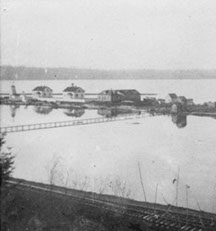
 Tidal lagoon -- Early 1900'sMost scholars agree that Native Americans were present in this part of North America at least 12,000 years ago, following the last Ice Age. They seemed to have arrived in the Puget Sound region more than 1,000 years ago. It appears that about 600 years ago the activity of Native Americans intensified in the area of our walking tour, based on the abundance of stone tools, bones, shells, and other artifacts beneath the soil surface.
Tidal lagoon -- Early 1900'sMost scholars agree that Native Americans were present in this part of North America at least 12,000 years ago, following the last Ice Age. They seemed to have arrived in the Puget Sound region more than 1,000 years ago. It appears that about 600 years ago the activity of Native Americans intensified in the area of our walking tour, based on the abundance of stone tools, bones, shells, and other artifacts beneath the soil surface.
Our walking tour is within the traditional territory of the Snohomish people who lived throughout present-day Snohomish County as well as the southern half of Whidbey Island. Their Snohomish dialect was one of several variations of the Lushootseed language, a term composed of the words for “salt water” and “language.” Lushootseed territories covered a large part of what is now western Washington, from present-day Bellingham south to the state capital of Olympia, and from the Cascade Mountains west to Hood Canal. The Lushootseed language, in turn, is a member of the Coastal Salish languages that were spoken historically throughout much of the Pacific Northwest.
Today, the Snohomish people are one of the Tulalip Tribes (pronounced Tuh’-lay-lup). Tulalip is actually a Snohomish name for the sheltered bay area near Everett that may be seen from the lighthouse across the water toward the north. The Point Elliott Treaty, signed here at Mukilteo in 1855, created the Tulalip Reserve (later a reservation) for the Snohomish, Snoqualmie, Skykomish, and “other allied tribes and bands.” Under the Indian Reorganization Act of 1934, the descendants of the original groups agreed to be organized as the Tulalip Tribes. The Tulalip Tribes today are working hard to maintain and even revitalize the essentials of their cultural heritage. Much more may be learned at their Hibulb Cultural Center (hibulbculturalcenter.org).
Some researchers believe permanent villages existed along Mukilteo’s north shore, but others argue that the local Indians only visited this area, mainly in the summertime. They spent their winters in large longhouses, often surrounded by palisades. These longhouses, constructed of massive cedar beams and planks, could reach five hundred feet in length and always housed several families. Lushootseed people also organized themselves into autonomous towns. Far from being isolated, these towns were linked through trade and marriage to other communities in Lushootseed territory and beyond. While conflict sometimes erupted between towns, intimate connections ensured a sharing of resources between neighboring communities. One of the most important traditions for maintaining these connections was the Sgwigwi, a word that simply means "inviting." The concept corresponds to the more familiar Northwest term, potlatch, in which people demonstrate and reinforce their social status by sharing their wealth with others.
Whether or not a town ever existed around here, there is no doubt that numerous gatherings occurred in this area in the past. There may have even been Sgwigwi events here, to which people from other tribes were invited because the area is so easily accessible. More will be learned in the future as archeologists, linguists, geologists, and others continue to gather more evidence of traditional Indian activities in the region, and discover more about the changes wrought by natural forces. What is already evident, however, is that the Lushootseed peoples thrived for centuries in the lands around Puget Sound. The climate was moderate, and sea food, game, berries, and edible plants were abundant. United by common cultural patterns, most of the groups appear to have lived in relative harmony with the land and with each other.
Copyright 2015, Mukilteo Walking Tour. All rights reserved.